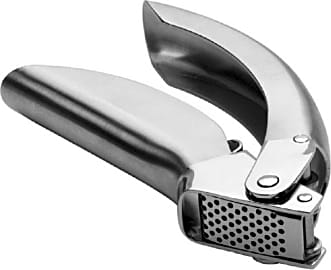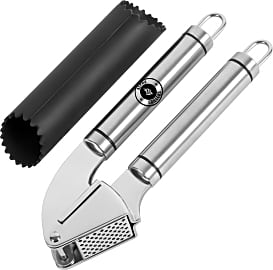The 10 Best Garlic Presses

This wiki has been updated 42 times since it was first published in June of 2015. A decent garlic crusher will not only make your meal prep faster and easier, it also helps to keep your hands cleaner. Additionally, these presses typically deliver more flavor and aroma than chopping or mincing by hand, so your pasta sauces, infused oils and other culinary masterpieces will turn out even tastier than before. When users buy our independently chosen editorial picks, we may earn commissions to help fund the Wiki.
Editor's Notes
May 24, 2019:
One of the most annoying things about using a garlic press is cleaning all the residue out of the holes afterwards. Some models, like the Zyliss Susi 3 and Wobrikosee 2-in-1, come with a cleaning tool attached to their handles, but the Oxo Good Grips takes care of that extra step for you with a built-in cleaner that pushes out any excess when you flip the handles. The Dreamfarm Garject has a similar self-cleaning mechanism, with the added benefit of an eject button for the peels. The Kuhn Rikon Epicurean has a durable, all-metal construction and is designed to require less effort than others, but because of the way the handles are shaped, it can pinch your skin if you're not careful.
The Joseph Joseph Rocker is an unconventional model that uses a combination of downward force and a rocking motion, so it's good for those with arthritis or limited hand strength. The garlic is collected in its bowl-shaped base, which can accommodate multiple cloves, but the holes are larger than those found in other models, so it's not the best option if you want a really fine mince. The Kitchen Innovations Garlic-A-Peel has two interchangeable blades that let you choose between tiny cubes or long, thin slices, along with a grating surface built into the base for making garlic paste. It's cute, compact, and dishwasher-safe, but the blades sometimes get clogged, so it can be annoying to clean by hand.
Why Everyone Needs A Garlic Press
Garlic cloves are usually very small, and most recipes require that you render them into incredibly tiny pieces, as too large a chunk would overpower a bite of food.
There is, perhaps, no vegetable whose properties have caused such equal portions of pleasure and disappointment as garlic. The flavors that diffuse throughout your sauces and sautés in its presence are unmistakably delightful. By the same token, however, the odors it leaves behind on the breath and–more importantly for our purposes–the fingers of whomever prepares the cloves are unmistakably repugnant.
Take, for one iconic example, the vampire. Vampirism evolved, at least in part, as a cautionary tale about seduction, as a way to warn women in particular not to fall for the guiles of an attractive man. From early folklore straight on through to the most recent film and television examples, there is almost no separation between vampires and sensuality. It makes sense, then, that the food serving as their primary culinary antithesis, as the one thing guaranteed to work against seduction, would be garlic.
What’s more, chopping garlic is dangerous business. Garlic cloves are usually very small, and most recipes require that you render them into incredibly tiny pieces, as too large a chunk would overpower a bite of food. Additionally, exposing more of the cloves internal area to your recipe will allow more of the flavor compounds to make their way into your dish. That kind of chopping, mincing, and dicing–especially if you don’t have a good chef’s knife–can quickly result in a lost or damaged finger.
What a garlic press does to ensure you won’t romantically repel those in whom you’re avidly interested, is allow you to prepare finely minced garlic cloves without ever touching a knife or putting your digits at risk.
Pressing The Issue
If you’ve ever filled your hand with something squishy and squeezed, then you know how a garlic press works. Whenever you apply pressure to a substance inside a chamber of porous material that’s stronger than the substance itself, that substance will break down and squeeze out through the chamber's pores. Go ahead and pick up a nice ripe tomato and slowly tighten your fist around it. Maybe wear safety goggles while you’re at it. At a certain point, the tomato will burst, and all of its innards will come oozing out between your fingers.
Go ahead and pick up a nice ripe tomato and slowly tighten your fist around it.
A garlic press better resembles a nutcracker or a hand juicer than a bare fist, in that it uses a hinge to increase the amount of pressure you can create with your hand. On one arm jutting out from the hinge is a small basket in which you can load one or more cloves of garlic depending on the unit’s design. On the other arm is a complementary press, a pusher with a flat surface that fits snugly into the basket. When you squeeze the handles together, the pressure of the pusher inside the basket eventually crushes the garlic clove and sends its smaller pieces out through holes in the basket.
Some presses have adjustable hole sizes, so you can fine-tune your garlic morsels to meet the needs of a specific recipe. Others have means by which you can change the amount of pressure that the unit applies to your garlic, which can be a big help for customers whose hand strength has faded over the years. It’s also a good idea to look out for units with removable components and included cleaning tools, as these will help you keep the smell off of your hands after you've gone to all the trouble to avoid touching the garlic in its preparation.
The Honorable Fight Against Garlic Breath
There’s a dangerous family of plants out there, the sole intention of which seems to be the end of human coupling. These plants, members of the allium family, are better known by their street names: onions, shallots, leeks, and garlic, to name a few. When you eat the products of one or more of these plants, they leave behind sulfuric compounds in the mouth that give an individual very bad breath. While this phenomenon can be particularly vexing on the dating scene or in the professional business world, it is relatively easy to remedy. A simple brush, floss, scrape, or mouthwash can usually do the trick.
While this phenomenon can be particularly vexing on the dating scene or in the professional business world, it is relatively easy to remedy.
A second, and significantly more nefarious means by which these plants infect our expiration is by means of absorption into the bloodstream. When you eat garlic, your body breaks it down into its nutritious components, each of which makes its way through your system in the bloodstream. Most of the compounds that enter your blood are simply very god for you, and eating garlic has a slew of health benefits associated with it.
One of these blood-borne compounds is called allyl methyl sulfide, and it’s actually a gas that moves from the blood into your lungs. Once this level of garlic circulation has occurred, the only perfect remedy is time, as the sulfuric aroma will continue to enter your lungs and crawl toxically out of your mouth with each breath until it’s left your system entirely. If you consume enough garlic, this compound will even permeate the skin when you perspire, causing a case of garlic body in addition to garlic breath.
There is one relatively simple way to help reduce the intensity of garlic breath that arises from your bloodstream. It turns out that those sulfuric compounds are highly acidic, so consuming foods with strong alkaline content, or that alkalize effectively in the body is a pretty well-tested way to fight the funk.
Many Italian dishes contain parsley, not just because it’s a delicious and complimentary herb to the flavor of garlic and onion, but also because its alkaline properties help fight bad breath. You can take this idea further by chewing on loads of parsley, drinking milk or tea, or consuming lemon in some form (which, despite its acidic nature, alkalizes in the body) to combat the effects of too much garlic in the blood.















